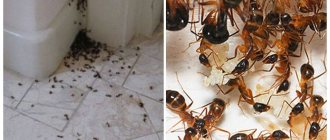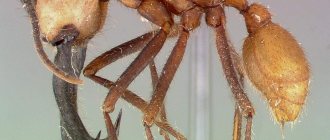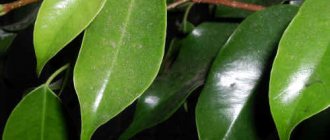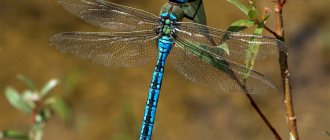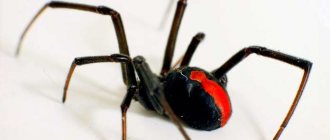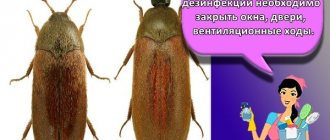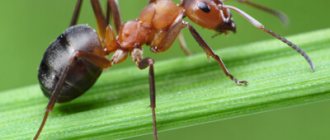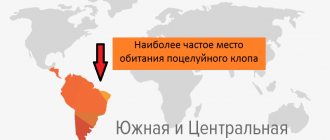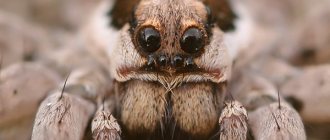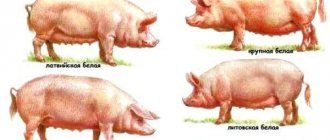- Wild animals
- >>
- Insects
The Colorado potato beetle (Leptinotarsa decemlineata) is an insect belonging to the order Coleoptera and the family of leaf beetles, belongs to the genus Leptinotarsa and is its only representative.
As it turned out, the homeland of this insect is the northeast of Mexico, from where it gradually penetrated into neighboring territories, including the United States, where it quickly adapted to climatic conditions. Over the course of a century and a half, the Colorado potato beetle has spread literally throughout the world and has become the scourge of all potato growers.
Origin of the species and description
Photo: Colorado potato beetle
The Colorado potato beetle was first discovered and described in detail by American entomologist Thomas Sayem. This happened back in 1824. The scientist collected several specimens of a beetle hitherto unknown to science in the southwestern United States.
The name “Colorado beetle” appeared later - in 1859, when an invasion of these insects destroyed entire potato fields in Colorado (USA). After a couple of decades, there were so many beetles in this state that most local farmers were forced to give up growing potatoes, despite the fact that their price had increased significantly.
Video: Colorado potato beetle
Gradually, year after year, in the holds of sea ships that were loaded with potato tubers, the beetle crossed the Atlantic Ocean and ended up in Europe. In 1876 it was discovered in Leipzig, and another 30 years later, the Colorado potato beetle could be found throughout Western Europe except Great Britain.
Until 1918, the breeding grounds of the Colorado potato beetle could be successfully destroyed, until it managed to settle in France (Bordeaux region). Apparently the climate of Bordeaux was ideal for the pest, as it began to rapidly multiply there and literally spread throughout Western Europe and beyond.
Interesting fact: Due to the peculiarities of its structure, the Colorado potato beetle cannot drown in water, so even large bodies of water are not a serious obstacle for it in its search for food.
The beetle allegedly entered the territory of the USSR in 1940, and after another 15 years it was already found everywhere in the western part of the Ukrainian SSR (Ukraine) and the BSSR (Belarus). In 1975, the Colorado potato beetle reached the Urals. The reason for this was a long, abnormal drought, due to which livestock feed (hay, straw) was brought to the Urals from Ukraine. Apparently, a pest beetle also came here along with the straw.
It turns out that in the USSR and other countries of the socialist camp, the mass spread of the beetle coincided with the beginning of the so-called “Cold War”, so accusations of an unexpected disaster were addressed to the American intelligence service CIA. Polish and German newspapers even at that time wrote that the beetle was deliberately thrown into the territory of the GDR and Poland by American aircraft.
Pest migration
It is unlikely that this pest will ever be completely eradicated. However, it is quite possible to protect your own potato plant from it. To destroy this pest, use:
- pesticides;
- biological agents.
In nature, this leaf-cutter beetle has practically no enemies. The only birds that eat it are pheasants, turkeys and guinea fowl. If there are such birds on the farm, they must be released into the potato field, that is, where the Colorado potato beetle lives. Among insects, its natural enemy is ladybugs, which, although they do not eat adult beetles, will not shy away from the opportunity to eat a couple of larvae. However, not all farms have pheasants, and not every garden can release them. Therefore, other methods have to be used.
The use of chemicals is limited by weather and timing. Nevertheless, there are products such as “Masterpiece” or “Prestige” that can be used for spraying plantings. The beetle does not get used to them. The toxic substances contained in them can accumulate in potato tubers.
The most effective method is spraying with a mustard-vinegar mixture. To do this you need to take the following ingredients:
- dry mustard - 1 kg;
- table vinegar 9% – 100 ml.
All this is thoroughly mixed with 10 liters of water. The resulting mixture is sprayed onto potato tops. This must be done in dry weather, making sure that the solution gets to where the Colorado potato beetle lives, i.e. under the leaves. It is also worth noting that it lives not only on potatoes, but also on other representatives of the nightshade family: tobacco, physalis, petunia.
At the moment, the pest is considered one of the most common parasites in the Russian Federation. But it was not always so.
Everything about the Colorado potato beetle became known to mankind in 1824. It was discovered by biologist Thomas Sayem. Squads of insects destroyed vegetable gardens in northeastern Mexico until they were introduced to North America. It was there that the pest got its name, consonant with one of the states of the country. It spread across huge potato fields in Colorado and virtually destroyed the crop.
The parasite was brought to Europe on cargo ships while transporting vegetables. After that, he lives in many countries, including Russia.
Parasites destroy the upper part of the tops, which is why the plant stops developing. Potato tubers are practically not formed. If there are too many insects on the plant, the ovary will not occur during flowering. And as a result, there will be no harvest.
Just 15 larvae on one plant can destroy half of all potatoes. If there are a lot of them, you can completely lose the harvest. Forty larvae or more destroy all potato tops.
Sometimes small insects appear on a summer cottage. According to the descriptions, the beetles are similar to Colorado beetles, but there are several differences. The insect reaches no more than 8 mm in length. There are not only black stripes on the wings, but also white and yellow ones. The legs of the insect are black. The abdomen is brown in color.
The homeland of the Colorado potato beetle is warm, sunny Mexico. For the first time, rural residents discovered a striped creature with a huge appetite in 1824. Initially, the insect ate tomatoes, bell peppers, eggplants, petunia leaves, and tobacco. With the active appearance of potatoes in the fields, Colorado moved to this crop. However, the story of the Colorado potato beetle does not end there, but is just beginning.
In 1959, the parasite caused enormous damage to potatoes in several states of Colorado in America. This is where the name came from. With the spread of shipping and active trade in potatoes, the insect began to colonize other continents. During the First World War, a massive appearance was discovered in France. American military bases were located in this country, where food and food supplies from the United States were transported to soldiers. Migration across Europe began from the French town of Bordeaux.
Colorado beetle
In what year the Colorado potato beetle was brought to Russia, there is no exact information. Presumably they began to import during the Second World War - 1943-1949. Some experts call the moment of settlement the beginning of hostilities, others - the end.
In 1949, a striped insect was discovered on the territory of Ukraine. The dry, hot summer of 1953 contributed to the resettlement throughout Ukraine, the Baltic states, and Belarus. Who brought the Colorado potato beetle to Russia is a question that interests many, since the insect’s large-scale sabotage resembles sabotage.
Appearance and features
Photo: Colorado potato beetle in nature
The Colorado potato beetle is a fairly large insect. Adults can grow up to 8 - 12 mm in length and approximately 7 mm in width. The body shape of the beetles is somewhat reminiscent of a water drop: oblong, flat at the bottom and convex at the top. An adult beetle can weigh 140-160 mg.
The surface of the beetle's body is hard and slightly shiny. In this case, the back is yellowish-black with black longitudinal stripes, and the belly is light orange. The beetle's black oblong eyes are located on the sides of its round and wide head. On the head of the beetle there is a black spot similar to a triangle, as well as movable, articulated antennae, consisting of 11 parts.
The hard and fairly durable elytra of the potato beetle fit tightly to the body and usually have a yellowish-orange, less often yellow, color, with longitudinal stripes. The wings of the Colorado potato beetle are membranous, well developed, and very strong, which allows the beetle to travel long distances in search of sources of food. Female beetles are usually slightly smaller than males and do not differ from them in any other way in appearance.
Interesting fact: Colorado potato beetles can fly quite quickly - at a speed of about 8 km per hour, and can also rise to great heights.
Where does the Colorado potato beetle live?
Photo: Colorado potato beetle in Russia
Entomologists believe that the average lifespan of the Colorado potato beetle is approximately one year. At the same time, some more hardy individuals can easily endure winter and even more than one. How do they do it? It’s very simple - they go into diapause (hibernation), so for such specimens, even three years of age is not the limit.
In the warm season, insects live on the surface of the ground or on the plants they feed on. Colorado beetles wait out autumn and winter, burrowing up to half a meter into the soil, and calmly tolerate freezing there down to minus 10 degrees. When spring comes and the soil warms up well - above plus 13 degrees, the beetles crawl out of the ground and immediately begin to look for food and a mate for procreation. This process is not too massive and usually lasts for 2-2.5 months, which greatly complicates the fight against the pest.
Despite the fact that the habitat of the Colorado potato beetle has increased almost several thousand times over the course of a century and a half, there are several countries in the world where this pest has never been seen and has no idea how dangerous it is. There are no Colorados in Sweden and Denmark, Ireland and Norway, Morocco, Tunisia, Israel, Algeria, and Japan.
Now you know where the Colorado potato beetle came from. Let's see what he eats.
What does the Colorado potato beetle eat?
Photo: Colorado potato beetle on a leaf
The main food of Colorado beetles, as well as their larvae, are young shoots and leaves of plants of the nightshade family. Beetles will find food wherever potatoes, tomatoes, tobacco, eggplants, petunias, sweet peppers, and physalis grow. They do not disdain wild plants of this family.
At the same time, beetles like to eat potatoes and eggplants most of all. Insects can eat these plants almost completely: leaves, stems, tubers, fruits. In search of food, they are able to fly very far, even tens of kilometers. Despite the fact that insects are very voracious, they can easily endure forced hunger for up to 1.5-2 months, simply falling into short-term hibernation.
Due to the fact that the Colorado potato beetle feeds on the green mass of plants of the nightshade family, a toxic substance, solanine, constantly accumulates in its body. Because of this, the beetle has very few natural enemies, since the beetle is simply inedible and even poisonous.
Interesting fact: Curiously, the greatest harm to plants is caused not by adult Colorado potato beetles, but by their larvae (stages 3 and 4), since they are the most voracious and are capable of destroying entire fields in a few days under favorable weather conditions.
Pest danger to potatoes
Hatching from eggs, the larvae can completely destroy the entire crop. They are most dangerous during the period of flowering and ripening of potato tubers.
Parasites destroy the upper part of the tops, which is why the plant stops developing. Potato tubers are practically not formed. If there are too many insects on the plant, the ovary will not occur during flowering. And as a result, there will be no harvest.
Just 15 larvae on one plant can destroy half of all potatoes. If there are a lot of them, you can completely lose the harvest. Forty larvae or more destroy all potato tops.
Features of character and lifestyle
Photo: Colorado potato beetle
The Colorado potato beetle is very prolific, voracious and can quickly adapt to various environmental factors, be it heat or cold. The pest usually survives unfavorable conditions by hibernating for a short time, and can do this at any time of the year.
The young Colorado potato beetle (not the larva) is bright orange in color and has a very soft outer covering. Within 3-4 hours after birth from the pupa, the beetles take on a familiar appearance. The insect immediately begins to feed intensively, eating leaves and shoots, and after 3-4 weeks reaches sexual maturity. Colorado potato beetles that were born in August or later usually hibernate without offspring, but most of them will make up for this loss the following summer.
One of the features unique to this type of beetle is the ability to go into long-term hibernation (diapause), which can last 3 years or even longer. Although the pest flies beautifully, which is facilitated by strong, well-developed wings, in moments of danger for some reason it does not do this, but pretends to be dead, tucking its paws to its abdomen and falling to the ground. Therefore, the enemy has no choice but to simply leave. Meanwhile, the beetle “comes to life” and continues to go about its business.
Social structure and reproduction
Photo: Colorado beetles
As such, Colorado beetles, unlike other types of insects (ants, bees, termites), do not have a social structure, since they are solitary insects, that is, each individual lives and survives on its own, and not in groups. When it becomes warm enough in the spring, beetles that have successfully overwintered crawl out of the ground and, having barely gained strength, the males begin to look for females and immediately begin mating. After the so-called “mating games,” fertilized females lay eggs on the underside of the leaves of the plants on which they feed.
One adult female, depending on the weather and climate of the area, is capable of laying approximately 500-1000 eggs during the summer season. Colorado eggs are usually orange, 1.8 mm in size, oblong-oval, located in groups of 20-50 pieces. On days 17-18, the eggs hatch into larvae, which are known for their gluttony.
Stages of development of Colorado potato beetle larvae:
- in the first stage of development, the larva of the Colorado potato beetle is dark gray in color with a body up to 2.5 mm long and small thin hairs on it. It feeds exclusively on tender young leaves, eating away their pulp from below;
- at the second stage, the larvae are already red in color and can reach sizes of 4-4.5 mm. They can eat the entire leaf, leaving only one central vein;
- in the third stage, the larvae change color to red-yellow and increase in length to 7-9 mm. There are no longer any hairs on the surface of the body of individuals of the third stage;
- at the fourth stage of development, the beetle larva changes color again - now to yellowish-orange and grows to 16 mm. Starting from the third stage, the larvae are able to crawl from plant to plant, eating not only the pulp of the leaves, but also young shoots, which causes great harm to the plants, slowing down their development and depriving farmers of the expected harvest.
All four stages of development of the Colorado potato beetle larva last approximately 3 weeks, after which it turns into a pupa. “Adult” larvae crawl into the soil to a depth of 10 cm, where they pupate. The pupa is usually pink or orange-yellow. The duration of the pupal phase depends on the weather. If it’s warm outside, then after 15-20 days, it turns into an adult insect that crawls to the surface. If it’s cool, this process can slow down 2-3 times.
Preventive measures
Prevention may not be able to protect your field 100% from parasite damage, but the number of harmful insects will definitely decrease. Let's see what measures gardeners take to protect their crops from attacks:
- Ash. If you have a small area allocated for potatoes, we recommend throwing a little ordinary wood ash into each hole; it will protect the plant from powdery mildew, late blight and beetles. In addition, ash stimulates the growth of the bush and strengthens the root system.
- Plants with a bright scent. This method is used by many gardeners; it is clear that it can only be effective in small areas. Plant plants with a strong smell along the rows and along the perimeter of the bed. Speech. First of all, we talk about dill, calendula, basil, tansy, coriander. The more of these fragrant crops you sow, the fewer Colorado potato beetles will be in your field.
- Crop rotation. Follow the rules of crop rotation, although beetles are able to move quickly, but if there have been no nightshades on the field for 2-3 years, then the risk of getting a large invasion of insects when planting potatoes or tomatoes is significantly reduced;
- Resistant varieties. Scientists have already developed a number of potato varieties that were not to the taste of the Colorado potato beetle. This does not mean that he does not use tops of these varieties at all - he simply moves to such a field when there is nothing else to eat. Most likely, by then you will have already harvested your crop.
- Seed material. Before planting potatoes, inspect the seeds; it should be borne in mind that a weak plant is more attractive not only to various infections, but also to the Colorado potato beetle;
- Seed preparation. Two to three days before planting potatoes, you should treat the seeds with a Colorado potato beetle protectant. You should choose a chemical that will have a complex effect on the tubers, that is, it will protect the bush from insects, parasitic fungi and will have a stimulating effect on the plant. There are quite a number of such drugs on the market, but we would advise you to take a closer look at the disinfectants Maxim, Prestige, Magnum Duo, Tirana, Tabu.
Natural enemies of Colorado potato beetles
Photo: Colorado potato beetle
The main enemies of the Colorado potato beetle are the Perillus bioculatus and Podisus maculiventris bugs. Adult bedbugs, as well as their larvae, eat the eggs of Colorado potato beetles. Also, a significant contribution to the fight against the pest is made by dorifophagous flies, which have become accustomed to laying their larvae in the body of the Colorado potato.
Unfortunately, these flies prefer a very warm and mild climate, so they do not live in the harsh conditions of Europe and Asia. Also, familiar local insects feed on the eggs and young larvae of the Colorado potato beetle: ground beetles, ladybugs, lacewing beetles.
It is worth noting that many scientists believe that the future in the fight against pests of cultivated plants, including Colorado potato beetles, does not lie with chemicals, but with their natural enemies, since this method is natural and does not cause severe harm to the environment.
Some farms specializing in growing environmentally friendly products use turkeys and guinea fowl to combat the Colorado potato beetle. These poultry love to eat both adults and their larvae, since this is a feature of the species, and they are accustomed to such food almost from the first days of life.
Use of insecticides
If preventive measures and folk remedies do not bring the desired result, and your field suffers from a pest invasion, you need to resort to drastic measures. Insecticides, which are available in large quantities, will help destroy the pest. When choosing a chemical, pay attention not only to its price, but also to its protective period, effectiveness and toxicity.
Regent. The poison belongs to the third class of toxicity, so it should be used strictly in accordance with the description and use personal protective equipment. Particular care should be taken when opening the ampoule - make sure that the poison does not get on the skin or in the eyes. To treat the field, only freshly prepared solution should be used. Maximum effectiveness is achieved if after spraying there is no rain for 7 hours. The death of pests and their larvae occurs within 14 hours after treatment with Regent.
Tanrek. Systemic insecticide, guaranteed to kill Colorado potato beetles and their eggs. The drug is resistant to precipitation and reliably protects nightshade crops from parasites for a long time. Tanrek belongs to the second toxicity class according to the WHO classification. Before using it, carefully read the instructions for use and strictly follow them. You should also be aware that this chemical may be harmful to bees.
Commander. A fairly effective and at the same time inexpensive remedy for poisoning the Colorado potato beetle. This insecticide is a low-toxic product, but it should not be used during the flowering period of potatoes, tomatoes and other crops, as Commander can kill bees that have visited your site.
